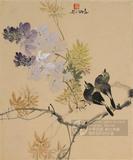清蔣木鼎松竹梅 軸
推薦分享
資源連結
連結到原始資料 (您即將開啟新視窗離開本站)後設資料
- 資料識別:
- 中畫000175N000000000
- 資料類型:
- 類型:繪畫
- 型式:靜態圖像
- 著作者:
- 蔣木鼎
- 主題與關鍵字:
- 松 竹 梅(白.紅.蠟梅) 溪澗、湍泉 奇石
- 出版者:
- 數位化執行單位:國立故宮博物院
- 格式:
- 本幅 228.7x59.5公分、全幅 73公分
- 關聯:
- 故宮書畫錄(卷八),第四冊,頁181&*故宮書畫圖錄,第十二冊,頁259-260&* 蔣檙,字作梅,江蘇常熟人。乾隆十六年(一七五一)進士入詞林,仕至兵部侍郎。以工寫花卉著稱。蔣氏一門為常熟豪門巨族,數代在朝為官,亦以繪畫見長,其中尤以檙之祖蔣廷錫、父蔣溥最具盛名。 松、竹、梅稱「歲寒三友」,為歷來文人畫家所喜繪之題材,藉以象徵清逸高潔的人格情操。畫中樹石點染細緻,筆墨清雋雅逸,呈現出蔣氏家傳風格特徵。 &* Chiang Ting (style name Tso-mei) was a native of Ch’ang-shu, Kiangsu. In 1751, he received his chin-shih civil service degree and entered the Hanlin Academy, later serving as Minister of War. He also became known for his flower paintings. Chiang came from a powerful clan of Ch’ang-shu which produced generations of officials as well as artists. Perhaps best known is Chiang Ting’s grandfather, Chiang T’ing-hsi, and father, Chiang P’u. Pine, bamboo, and plum blossoms are known as “The Three Friends of Winter,” a subject often depicted by literati artists starting in the Sung dynasty (960-1279). Literati chose these three subjects for their ability to thrive in winter, similar to the scholar who perseveres through hardship. Thus, they became symbols of purity and integrity of spirit. In this painting, the dots and washes on the stones and trees are delicate, and the brushwork is elegant and untrammelled -- expressing the characteristic Chiang style.
- 管理權:
- 國立故宮博物院
授權聯絡窗口
- 國立故宮博物院圖像授權、出版授權、影音資料授權-申請流程說明
http://www.npm.gov.tw/zh-TW/Article.aspx?sNo=03003061






